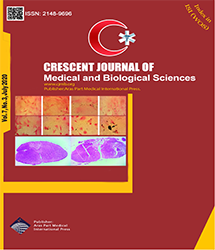
| Original Article | |
| Assessment of Albendazole and Mebendazole Effects on the Excretory/Secretory Proteome of Gastrointestinal Strain of Echinococcus granulosus Protoscoleces Using Two-Dimensional Gel Electrophoresis | |
| Mohsen Eshraghi1, Seyed Jafar Adnani Sadati2,3, Ali Farahank4, Hakimeh Zali5, Babak Aghili3 | |
| 1Department of Surgery, Shahid Beheshti Hospital, Faculty of Medicine, Qom University of Medical Sciences, Qom, Iran 2Cellular and Molecular Research Center, Qom University of Medical Sciences, Qom, Iran 3Department of Medical Microbiology and Immunology, Faculty of Medicine, Qom University of Medical Sciences, Qom, Iran. 4Department of Parasitology and Mycology, School of Public Health and Institute of Public Health Research, Tehran University of Medical Sciences, Tehran, Iran. 5School of Advanced Technologies in Medicine, Shahid Beheshti University of Medical Sciences, Tehran |
|
|
CJMB 2020; 7: 322-330 Viewed : 4789 times Downloaded : 3193 times. Keywords : Protoscoleces, Albendazole, Mebendazole, Proteome, Two-dimensional gel electrophoresis |
|
| Full Text(PDF) | Related Articles | |
| Abstract | |
Objectives: The larval stage of Echinococcus granulosus in the internal organs of a human causes cystic hydatidosis. Thus, the identification of excretory/secretory (E/S) proteins from E. granulosus protoscoleces may help to discover new candidates for drug targets, along with immunodiagnostic and vaccine products. The purpose of this study was to assess the efficacy of albendazole and mebendazole on protein spots of E/S products of hydatid cyst protoscolices which can be helpful for detecting some target proteins for therapeutic purposes. Materials and Methods: In this experimental study, protoscoleces were divided into three groups in order to assess the effects of the drug. The first and the second groups were treated with albendazole/mebendazole, respectively, and the third group was considered as control. To determine the proteome spots, E/S proteins were precipitated with trichloroacetic acid/acetone and loaded on the isoelectric focusing gel, resulting in gel differentiation on sodium dodecyl sulfate-polyacrylamide gel electrophoresis with the 20 mA constant current. In addition, the gels were stained with Coomassie Brilliant Blue. Finally, the protein spots resulted from 2-DE gels were analyzed using the Progenesis SameSpots software. Results: The comparison between the proteome gels of the treated groups and the control group showed that 35 protein spots are paired among which, 11 spots had significant differences in their expressions (P < 0.05). Conclusions: In general, the comparison between the expression levels of protein gel spots indicated the increasing expression of some protein spots while the suppression of the others. This suppression can be considered as a specific effect of the drugs on the E/S product of the protoscoleces of hydatid cyst. |
Cite By, Google Scholar
Google Scholar
PubMed
Online Submission System
 CJMB ENDNOTE ® Style
CJMB ENDNOTE ® Style
 Tutorials
Tutorials
 Publication Charge
Medical and Biological Research Center
About Journal
Publication Charge
Medical and Biological Research Center
About Journal
Aras Part Medical International Press Editor-in-Chief
Arash Khaki
Deputy Editor
Zafer Akan


















